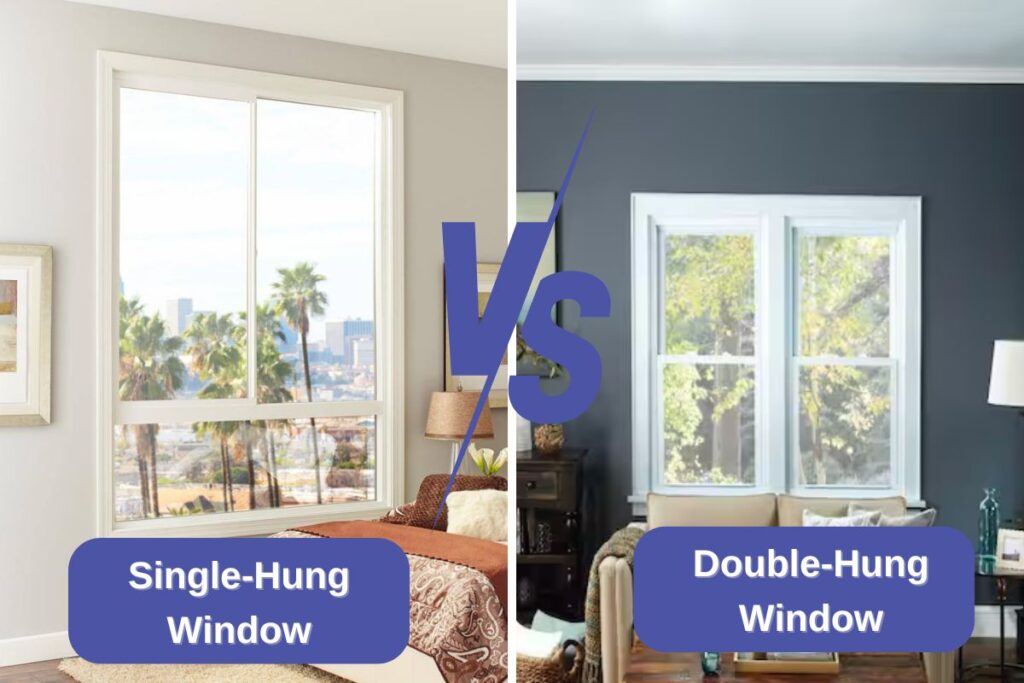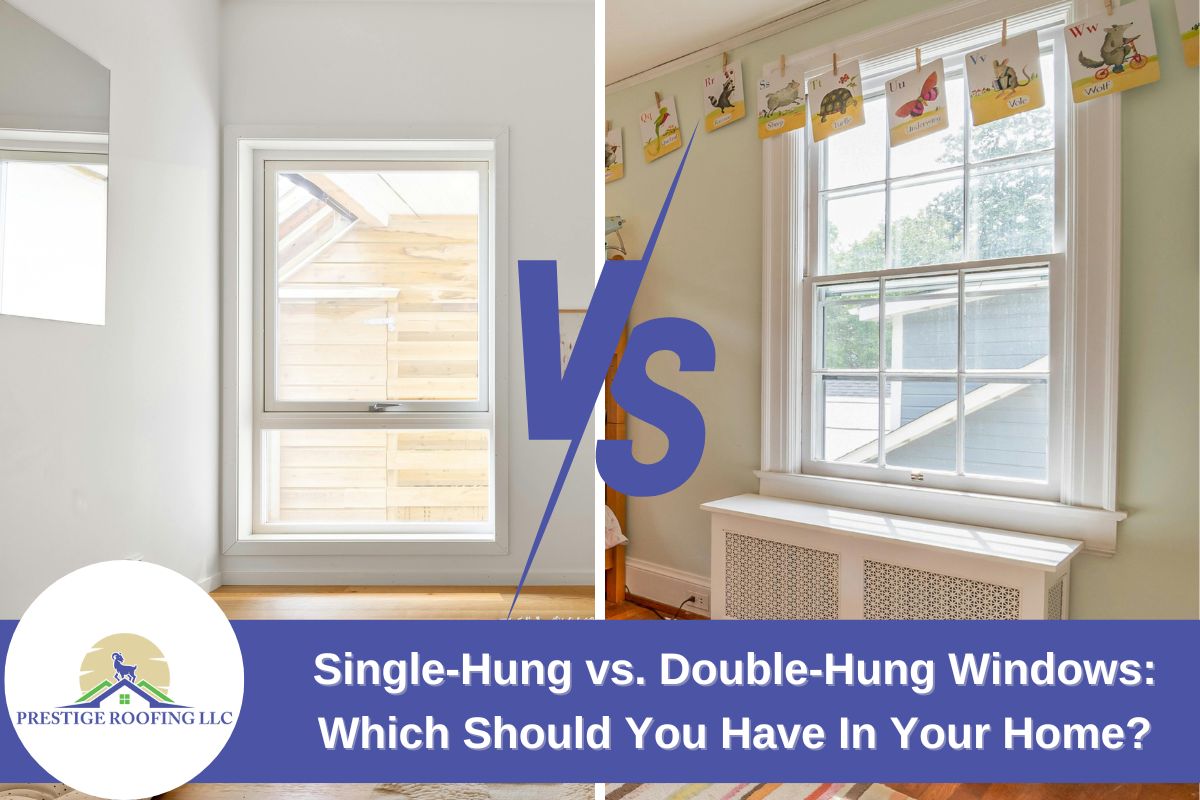When you’re planning to replace or install new windows in your home, one of the first decisions you’ll face is whether to choose single-hung or double-hung windows. At first glance, they look similar, but as any experienced contractor will tell you, the difference between the two runs deeper than just how they open. It impacts airflow, how easy your windows are to clean, how energy efficient they are, and how much value they add over time.
As a company that’s worked with homeowners on thousands of window installations, we know how easy it is to feel overwhelmed by the options. That’s why we’ve decided to offer you an effective comparison of both single-hung and double-hung windows.
Single-Hung vs. Double-Hung Window: The Basics

Source: homedepot.com
As we mentioned in the introduction, both single-hung and double-hung windows have a similar structure, but they operate differently.
Single-hung windows have two panels (called sashes), but only the bottom one moves. The top sash is fixed in place.
Double-hung windows, on the other hand, have two movable sashes. You can move both the top and bottom sashes, and some modern options allow the sashes to tilt inward, making them easier to clean.
Now you might be thinking, that’s just a single point of difference and might not make much change. But this one operational difference affects nearly everything else about how these windows function in your home. Let’s get into it.
Also Read: 22 Different Types of Windows For Your Home
Ventilation (Air Flow/Circulation)
Single-Hung Windows
Single-hung windows only allow ventilation through the bottom sash. That means your airflow is limited. If your home tends to get hot upstairs or in areas with poor circulation, this can be a problem, and your home would benefit from more ventilation options.
Double-Hung Windows
With double-hung windows, you can open the top and bottom sashes at the same time. Cool air comes in from the bottom, while warm air naturally escapes through the top. This creates a natural convection current that can help cool your home more efficiently. Though you may still need the AC, you’ll be using it a lot less.
With pets or young kids, having the ability to just open the top sash gives you airflow without worrying about whether anyone (or anything) is climbing out.
Energy Efficiency: How Much You’ll Spend on Heating and Cooling
Energy costs add up, and windows play a major role in how your home retains heat or stays cool. Here’s how the two types compare:
Single-Hung Windows
Because single-hung windows have fewer operable sections, there are fewer points where air can leak from. The top sash is sealed permanently, which helps with insulation, making this window option slightly more energy efficient, especially if you’re not using high-end models.
Double-Hung Windows
Traditionally, double-hung windows had more potential leak points, but today’s manufacturing advances have changed that a long way. Features like the multi-pane glass, low-E (low-emissivity) coatings, and tight weather-stripping have improved the energy performance of double-hung windows significantly.
If energy savings are a top priority, focus less on the style and more on the overall window quality, glass package, and installation.
Also Read: Best Window Brands For Your Home
Window Installation and Future Costs
Window costs vary depending on size, material, brand, and installation complexity. But on average:
Single-Hung Windows
Single-hung windows are less expensive to buy and install. If you’re replacing many windows or working with a tight budget, the difference in cost can really add up. Fewer moving parts can also mean fewer things to break over time, which can reduce maintenance costs.
Double-Hung Windows
Double-hung windows usually cost more up front. Due to their opening from both sashes, these windows cost about 10% or 20% more than single-hung windows per unit. But many homeowners feel the extra investment is worth it for the added functionality, easier cleaning, and improved airflow.
If you’re planning to stay in your home for the long haul, that convenience can pay off in both comfort and long-term value.
Also Read: How Much Do Window Replacements Cost In Wisconsin?
Window Appearance and Versatility
Apart from bringing in fresh air and sunlight, windows also play a crucial role in improving the curb appeal of your home. Luckily, both window options come in a wide variety of styles, colors, and finishes.
Single-Hung
Single-hung windows are commonly found in older homes and traditional architectural styles like Craftsman, Colonial, or Farmhouse. They tend to have a classic look that fits well in homes aiming for a historic or simplified aesthetic.
If you’re restoring a vintage home or working with an HOA that favors period-correct features, single-hung might be the better match.
Double-Hung Window
Double-hung windows are a favorite in both classic and modern homes. They’re especially popular in urban areas, new builds, and transitional designs. With grid options, frame styles, and hardware finishes to choose from, double-hung windows offer the flexibility to suit almost any home style.
Cleaning and Maintenance:
Let’s be honest — no one loves cleaning windows. But clean windows make a big difference in how your home looks and feels. So, it matters how easy (or hard) it is to get them sparkling.
Single-Hung Windows
With single-hung windows, usually only the bottom sash tilts in. The top sash stays put, which means cleaning the exterior (especially upstairs) requires either getting outside access or hiring a pro. In single-story homes, this might not be a big issue, but for anything above ground level, it adds time and hassle.
Double-Hung Windows
Modern double-hung windows almost always come with a tilt-in feature on both sashes. That means you can clean the outside surfaces from inside your home, even on upper floors. If you’ve got a two-story house, this is a big deal. No ladders, and no dangerous balancing acts.
What’s Best for You? A Quick Breakdown
Here’s how to think about it based on your situation:
Choose Single Hung if:
- You’re on a tight budget and need to replace many windows at once
- You live in a single-story home, so exterior cleaning isn’t a big issue
- You want a simple operation and minimal maintenance
- You’re restoring a historic home and want to match original details
- You’re in a mild climate where airflow isn’t a big concern
Choose Double Hung if:
- You have a multi-story home and want safe, easy cleaning from the inside
- You value flexible ventilation and energy flow
- You have kids or pets and want to open windows from the top for safety
- You plan to stay in your home long term and want comfort over time
- You’re upgrading to high-efficiency windows and want modern features
Install Quality Windows With The Experts at Prestige Roofing LLC
Both single and double-hung windows are great window options, so it just depends on your home, budget, and your priorities. The most important thing? Make sure the windows themselves are high quality and that they’re installed by a professional who knows what they’re doing. Even the best window won’t perform well if it’s poorly installed.
At Prestige Roofing LLC we have window installation experts who have years of experience installing both single and double-hung windows. Contact us today at (920) 791-0414 to learn more about how we can help you!
FAQ’s
Are Single-Hung Windows Cheaper Than Casement Windows?
Yes, single-hung windows are typically more affordable than double-hung and casement windows. Their simpler design — with only one movable sash — means fewer mechanical parts and easier installation. Casement windows, which swing open like a door, tend to cost more due to their hardware and sealing features.
How Long Does A Single-Hung Window Last?
A quality single-hung window typically lasts 20 to 30 years with proper care. Lifespan can vary based on the material (vinyl, wood, aluminum), climate conditions, and maintenance. Regular cleaning, sealing, and inspections can help maximize their durability and performance over time.

